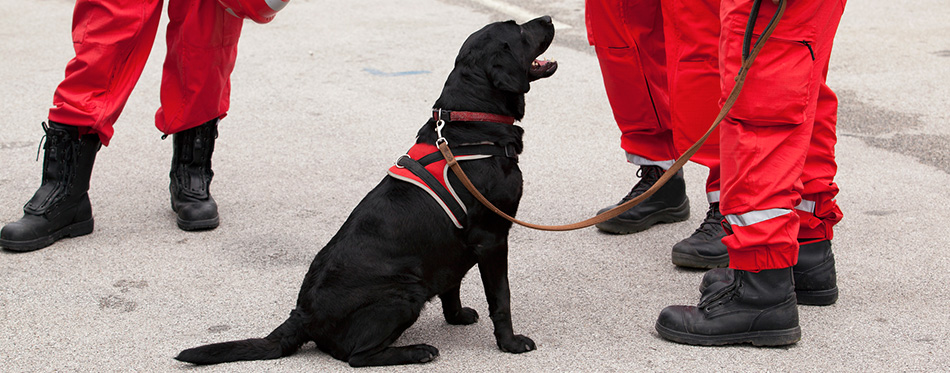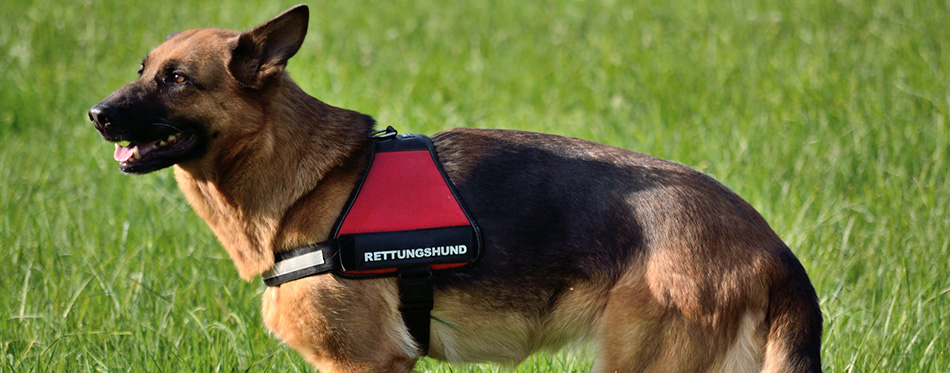There’s an increasing number of Americans who identify as having disabilities. With this fact comes the increasing need for support animals such as service dogs. You can see these animals frequently walking on the streets with their owner who may be visually or hearing-impaired. Although you can see a lot of these dogs roaming around, not a lot of people who need them know how to get one for themselves. In this guide, we’ll teach you how to get your very own service dog.

What is a Service Dog?
Before we talk about how you can get a service dog to call your own, we have to talk about what a service dog is and how it’s different from just any pet dog first. The Americans with Disabilities Act or the ADA describes service animals as those that are specifically trained to perform tasks for the benefit of people with disabilities. These disabilities can be sensory, physical, psychiatric, or intellectual in nature. People with these difficulties can bring their service dogs to any public space, so long as they don’t cause any unnecessary disturbances.
Many companies that provide service dogs do so at minimal cost. They may even provide them free of charge for those in need, particularly for army veterans. This is possible since they receive lots of donations from charitable institutions as well as individuals who just want to lend a helping hand. Not only do these groups supply service dogs, they also play a major part in training them. Some even allow dog owners to sign their pooches up for training so they can become service or support animals, if they have the right demeanor.
Service dogs are bred and trained to have a specific temperament. This is why you’ll see more German Shepherds and Golden Retrievers acting as service dogs for people with disabilities compared to Shih Tzu’s and Chihuahuas. Dogs that are easily distracted unfortunately can’t become service animals. Service dogs need to be calm and at the same time energetic. They must also enjoy being with people, even those who are unfamiliar. They should also be able to keep their focus on a single task for a prolonged duration.
Service dog differ quite a bit from facility or therapy dogs, as the latter is better suited to provide support as opposed to assisting with activities of daily living. Therapy dogs can also serve more than one person. For instance, they can provide emotional support for all the inpatients of a hospital ward. On the other hand, service dogs are exclusively matched to a single person. Unlike service dogs, facility and therapy dogs also can’t roam around public spaces as much.
Related Post: Tactical Dog Vests
The Steps in Getting a Service Dog
Now that we’ve talked about what a service dog is and how it compares to other animals, let’s now discuss how to obtain a service dog. To get one, you’ll need to get a written document from your healthcare provider, which states that you’re currently undergoing treatment for a disability or a psychiatric problem. This record also has to state that you’re in need of the assistance of a dedicated service animal to help you accomplish everyday tasks. Once you have this document, all you need to do is submit it to the appropriate organization.
For certain service dog training centers, you may also be required to submit an application form to get a service animal. You can send this by mail or through the Internet. Some institutions may even need to interview you via a phone call or personally during a home visit. This way, they can see if you’re truly in need of a service dog. If they decide that you are, they’ll put you on their waitlist once you’ve processed the necessary fees for their program.
You can get a service dog from many different organizations, but you may have to wait a while before you’re the next in line to receive one. This could be due to the long time it takes to train these animals or simply because of the high demand for them. Depending on what kind of disability you have, the steps you need to take to get a service dog may be different. A person with a physical disability may have a more difficult time getting a service animal compared to someone with a visual impairment, or vice versa.
The waiting times for a formally-trained service dog can be extremely long. Because of this, some pet owners with disabilities have resorted to training their very own dogs to help them with everyday tasks. This could be done by signing them up for a specific training program or by having them taught by independent trainers. If your service dog only needs to help you with simple tasks, there are resources available online that you can use to teach them on your own.
Who Can Service Dogs Help?
Those who suffer from blindness and other forms of visual impairments have a lot of institutions dedicated to providing them with service animals. If a service dog’s owner is visually impaired, a service dog can guide them across busy traffic or even through the obstacles in their own home. On the other hand, a person with difficulties in hearing can have a service dog that alerts them to crucial noises such as doorbells when there’s a visitor, alarms when there’s an emergency, and honking horns when there’s oncoming traffic. Take a look at our review of dog doorbells for more options.
Physical impaired people can also benefit from having a service dog. These animals can push doors open for their owners or move obstacles that are blocking their way. In some cases, they can even pull a person’s wheelchair along to help them get to where they need to go. People with mental problems also have a need for service dogs. For instance, soldiers who have just come from the battlefield could be suffering from post-traumatic stress disorder or PTSD. Specially trained service animals can wake these heroes up if they’re having nightmares. They may also divert their owner’s attention from things that could potentially trigger them.
There have also been cases wherein service dogs have been used to assist children with developmental concerns such as Autism Spectrum Disorder (ASD). They help sensory-seeking children by applying pressure to certain spots on their body. A service dog may also help a child with ASD by diverting their attention from possibly overwhelming stimuli. However, this requires even more rigorous training compared to the type that regular service dogs go through. Although, it’s well worth it if your service dog ends up saving your life.
Similarly, there are service dogs that have been trained to sense the warning signs of an oncoming seizure. If they detect an epileptic fit coming, they’ll bark as loud as they possibly can to alert nearby family members. This will allow them to contact emergency medical personnel to provide swift aid. They may also move to break the fall of a person who has an attack while standing or sitting. Meanwhile, other service dogs can be trained to detect low blood glucose in diabetics simply by taking a whiff of their breath.
Even more impressive is how some service dogs can keep track of when their owners should take their medications and remind them to do so if ever they forget. This is particularly helpful for those who need these drugs to manage their mood swings or another preexisting condition. There are even service dogs who can contact emergency services using a specialized canine phone. Who would have ever thought that your pooch could save you in a life or death situation? As it turns out, they do a fairly good job at it.

Where Can You Get a Service Dog?
Organizations such as The Seeing Eye and Leader Dogs for the Blind have been providing these helpful creatures for the visually impaired for years and years now. They’ve also become quite successful since their establishment. You won’t go wrong with choosing any one of these since you can rest assured that you’ll be getting a helpful partner for life. If you’re hard of hearing, you may want to check out Hearing Dogs for Deaf People as well as the Hearing Dogs sector of Paws with a Cause.
If you or someone that you know is currently suffering from a mental disability, then Canine Companions for Independence as well as the Great Plains Assistance Dogs Foundation have got you covered. Both of these organizations offer sizable scholarships for deserving people, so there’s no need to worry about shelling out a large amount of your hard-earned money. Those with physical ailments can count on companies such as Summit Assistance Dogs and 4 Paws for Ability. The former has service dogs that cater for all ages, while the latter has them specifically suited for a much younger demographic.
There’s everything you’ve ever wanted to know about getting a service dog. As it turns out, these helpful pooches aren’t only for the visually impaired – there are those that are specifically trained for the hard of hearing, for the physically challenged, and for those who have mental issues, among other conditions. If you need a service animal, don’t wait any further to sign up for one.

